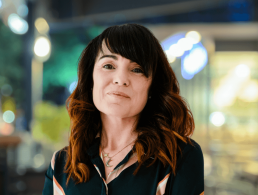Entrepreneur Dora Palfi discusses the work that still needs to be done for women in STEM and how her edtech company ImagiLabs came about.
The challenge around diversity and inclusion in tech often requires solutions from multiple sides of the problem.
Companies and industries as a whole need to do more to ensure the sector is as inclusive as possible and that it is successfully attracting and retaining diverse talent.
But there is also the question around education, particularly when it comes to women in STEM. There are many people advocating for education systems to encourage more young women and girls into science and tech disciplines, one of whom is Dora Palfi.
Palfi is the co-founder and CEO of ImagiLabs, a Sweden-based edtech company making products that empower girls with the skills and community to create with technology.
She also has a bachelor’s degree in neuroscience with a minor in computer science from New York University Abu Dhabi and has studied human-computer interaction at KTH Royal Institute of Technology in Stockholm.
‘Coding is a superpower. It’s the literacy of the next generation’
– DORA PALFI
“While science has always been a great interest of mine, it wasn’t until university that I discovered that technology – and more specifically, programming – could be a career path for me to pursue in and of itself,” she told Siliconrepublic.com.
“Since graduating, my career has taken me from working as a developer at Morgan Stanley and UX designer at Cisco, to my master’s degree in human-computer interaction.”
She said her passion for advocating for diversity and inclusion in tech came from her time at university, where she was shocked by the disproportionate ratio of men to women – not just with her fellow students, but with professors and speakers too.
Fast-forward to now and Palfi has set up ImagiLabs with her friend Beatrice Ionascu.
“Every day I find myself utilising my own background in technology, with the hope of making it a more inclusive sector,” said Palfi.
The edtech start-up has developed a mobile-first community for pre-teen and teen girls interested in technology. Last year, the company launched ImagiCharm, a wearable device with an 8×8 matrix of LED lights that can be visually customised with an accompanying mobile app.
“Users can learn the basics of Python programming by changing the appearance of their accessory, making coding visual, tangible, relevant, self-expressive and, most importantly, fun,” Palfi said.
“We believe that coding is a superpower. It’s the literacy of the next generation. By encouraging girls to learn programming, we are giving them the opportunity to be the inventors, entrepreneurs and changemakers that will help to design our future digital society.”
Making STEM an equal playing field
Gender diversity in STEM is an issue that has been widely discussed and there are plenty of positive moves in the right direction that will help move the needle.
Earlier this year, 45 companies signed a pledge committing to make Irish workplaces more inclusive, including gender pay gap analysis.
Industry giant Intel recently launched a new manufacturing skills course for women, teaching skills across electronics, electrical and project management. And non-profit Fastrack into IT is on a mission to grow Ireland’s tech talent pipeline with a new apprenticeship programme focusing on women.
However, Palfi said there is still a long way to go, with women in Europe still making up less than 30pc of the workforce for many tech roles.
“In terms of gender-related gaps, there’s actually very little difference between boys and girls in early ages,” she said.
“But we see the number of women interested in STEM drop off as they get older. According to a study by Google and Gallup, 12-year-old boys and girls share a similar interest in computer science. But by 14, only 12pc of girls are interested in computer science, compared to 47pc of boys.”
Palfi believes this is because girls are put off by a lack of support, representation and resources tailored to them.
“Many girls feel discouraged from pursuing careers in STEM not only because of the lack of visible role models in these sectors, but also because of a lack of leadership and encouragement from a young age,” she said.
“We need more initiatives that directly invite underrepresented demographics into the fold so that we can diversify the playing field.”
Palfi also said that there is much-needed myth-busting around what a career in STEM is, with some TV shows and mainstream media giving a “narrow and potentially off-putting idea” of what it means to be a scientist or mathematician.
“STEM fields are stimulating and often demand creativity, which is why diverse teams are so crucial to research and development!”
From her own experience, Palfi said she spent much of her education and career in male-dominated sectors and has become used to being one of the only women in the room.
“People are sometimes surprised when I tell them I’m the founder of a tech company, especially a hardware company,” she said.
“This is only because we don’t have enough role models in these kinds of positions, and seeing young, successful women in STEM is still shocking to many, despite the fact that our numbers are growing. Hopefully with time, more light will be shed on women in STEM who are making a difference, so that we can provide more role models for young girls.”
Advice for young women
While the onus should be on governments, educational bodies and STEM companies to make the industry more inclusive and diverse, what can young women do in the meantime to forge their own path in STEM?
“I encourage girls to find mentors and role models,” said Palfi. “In such an unequal environment, girls need all the help and encouragement they can get.”
With this in mind, she also said women and girls should find like-minded friends and community members in their area of interest.
“These don’t have to be expensive summer schools, they could be a local club, or even an online tool and community like ImagiLabs, which connects coding girls all over the globe,” she said.
“Another suggestion I would make is for young girls to combine their other interests with STEM. From building an app that supports your local community, learning about the science behind innovative solutions to climate change or using technology for social activism, there are so many ways that girls can integrate STEM into their everyday lives and pursuits.”
Want stories like this and more direct to your inbox? Sign up for Tech Trends, Silicon Republic’s weekly digest of need-to-know tech news.




